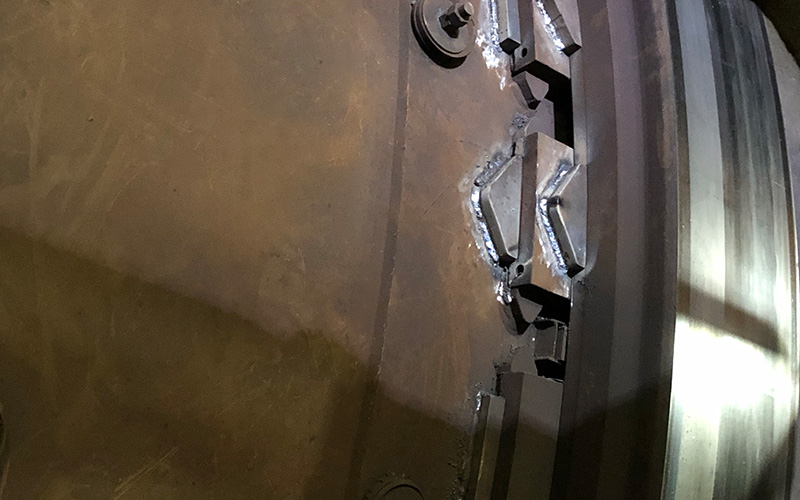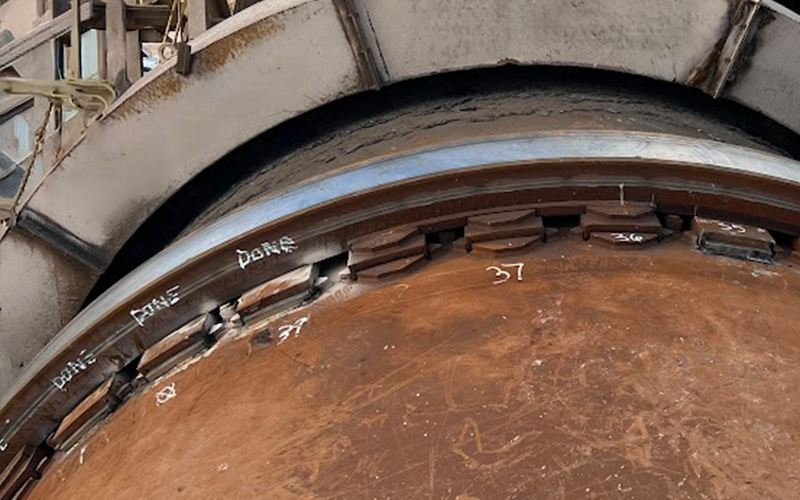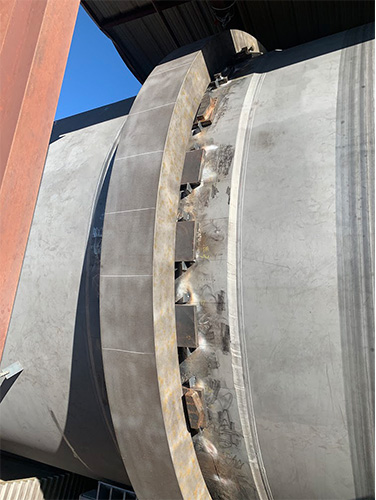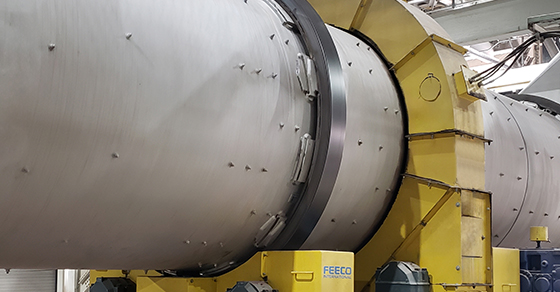Rotary drum tires, or riding rings, are critical components of any rotary drum system, maintenance of which is key to prolonging equipment service life and minimizing unnecessary downtime.
From fertilizer granulation to ore drying, precise geometry ensures even load distribution, smooth rotation, and equipment integrity. When floating blocks can no longer be held in place via shimming adjustments, due to too much radial or axial play, when too much axial play exists between keeper blocks and tire sidewall, or when the shims stack is too large to be held in place, remounting becomes an essential procedure for restoring the tire-to-shell interface.
Note: FEECO utilizes the floating tire mounting style, in which flotation blocks are held in place by keeper blocks, instead of being welded to the shell. While we recommend the FEECO floating tire design, we can also assist in remounting wedged (fixed) tires. Shrink-fit tires can be provided as part of a shell section replacement as well.
What Is Tire Remounting?
Tire remounting is the complete removal and replacement of the mounting system and all of its components (reusing the tire). This process resets the tire-to-shell interface for a clean, mechanically sound mount.
What Does the Tire Remounting Process Look Like?
During a remount, the shell and tire bore are cleaned, inspected, and repaired as needed. Any shell cracks should also be repaired during this time.
Once the drum is inspected and cleaned, technicians begin laying out and installing the new mounting hardware. After the mounting assembly is installed, the tire is then remounted and carefully positioned over flotation blocks and between side keepers.
Technicians then verify tire alignment and proper contact pattern with trunnions. Final adjustments are made to ensure the tire is seated evenly and aligned with the rest of the support system.
Because this is a major repair involving structural components, a realignment of the trunnion bases should also be performed after a remount.

Finished tire field remount
Is the Tire Removed During Remounting?
Tire remounting can be approached in two ways: moving the tire alongside its existing location, or replacing mounting components in-situ, with moving the tire being the preferred approach.
Moving the Tire
In this approach, the tire is moved a few feet over on the drum, onto temporary work bases. This approach is ideal because it allows for unrestricted access to the mounting components and underlying shell. For this reason, when shell crack repairs are required, the tire must be moved.
Once the mounting components have been replaced, the tire can tbe moved back into place.
Replacing Mounting Components In-Situ
If shell repairs are not required and surrounding infrastructure does not permit tire movement, the mounting assembly can be replaced while the tire remains on the trunnion wheels. In this scenario, one-to-two filler bar mounts are replaced at the 12 o’clock position on the drum. The drum is then rotated incrementally so technicians can work on each consecutive filler bar.
Whether the tire is moved or not, proper care and planning are critical to maintaining a safe remount procedure.

In-situ tire remount in progress
When Is Tire Remounting Necessary?
Remounting typically becomes necessary after repeated reshimming or when signs of more advanced misalignment and wear appear. Indications that remounting may be necessary include:
- Tire creep or migration beyond float limits
- Presence of axial runout
- Running (hot) gap is too big to keep shims in place
- Wear on side keepers
- Visible scoring, pitting, or wear on the tire bore or shell
- Excessively worn flotation blocks
While reshimming can address early-stage issues, remounting becomes critical when the tire is no longer properly seated, requiring a complete interface reset.
The exact timeline for remounting depends on a system’s unique operating conditions. FEECO recommends anticipating a remount after two reshims, or at around five-to-ten years after installation. Both tires may be remounted at the same time or separately, depending on their condition.
The Risks of Delaying Tire Remounting
Delaying a tire remount can compound mechanical issues and drive up future maintenance costs. Continued operation with a misaligned or improperly supported tire may:
- Lead to uneven or accelerated trunnion wear, requiring resurfacing or replacement
- Cause shell fatigue or damage that eventually demands shell replacement (mounting system dependent)
- Affect gear backlash
- Cause damage to the tire due to fatigue and/or localized stress points
- Lead to unplanned shutdowns
- Cause the tire to “walk off” support rollers
- Result in seal damage and misalignment between drum and breechings
Tire Remounting Considerations
Plan Ahead
Given that remounting requires downtime and extensive lead time for parts, maintenance managers need to plan well in advance for the tire remounting procedure.
The need for remounting should also be assessed ahead of time. Maintenance managers should keep records of reshimming procedures and plan for a remount after two reshims. FEECO recommends conducting annual rotary drum inspections, during which signs of wear can be identified through preventive maintenance care and may indicate the need for an earlier remount.
It is also best practice to bring in a qualified service provider to evaluate the drum and tire’s condition to provide a recommended timeline for remounting. In some cases, interim repairs may be possible to push the procedure out until a planned maintenance outage.
During this evaluation, technicians inspect the condition of the tire, shims, and shell surface to confirm that remounting is necessary and to plan the best approach to resolution.
Knowing When Tire Replacement is Necessary
It’s important to note that in some cases, the tire may be too worn or damaged for remounting. If the tire bore/inside diameter (ID) is heavily scored, warped, or excessively worn, a new tire may be required, particularly if:
- Tire cracks or deformations are present
- Tire thickness is below the minimum design standard
Welding repairs may be an option for tire cracks as a temporary fix while planning for a new tire delivery and installation.
Benefits of Tire Remounting
When performed at the right time, tire remounting:
- Restores proper support to the drum shell
- Helps to correct misalignment and reduce vibration
- Extends the life of tires, trunnions, and bearings
- Reduces long-term maintenance costs
- Eliminates tire creep and axial runout
By resetting the tire-to-shell interface, operators prevent the gradual degradation that can lead to catastrophic tire or shell failure and costly downtime.

Tire remount and shell repair in progress
Why Choose FEECO for Tire Remounting
FEECO’s customer service team brings decades of experience working with rotary drums across industries. We have the expertise and equipment to assess tire and mounting assembly condition, as well as reshim, remount, and even replace tires with precision. These services are part of a broader suite of rotary drum maintenance solutions, including inspections and audits, tire and trunnion grinding, and spare parts, meaning we can offer the full spectrum of services necessary to keep your drum running its best.
As an alternative, we can also offer remounting supervision services for plants wanting to carry out the work in-house.
Conclusion
Tire remounting plays a critical role in preventing costly damage and extending equipment life. Whether you’re addressing ongoing issues or planning proactive maintenance, FEECO’s experienced service team is equipped to return your drum to optimal performance.
From inspections and realignments to full drum rebuilds, FEECO provides lifecycle support for every stage of rotary drum performance and can offer a turnkey solution to tire remounting, bringing a team to your facility and managing the work. To learn more or schedule an evaluation of your rotary drum system, contact us today!

